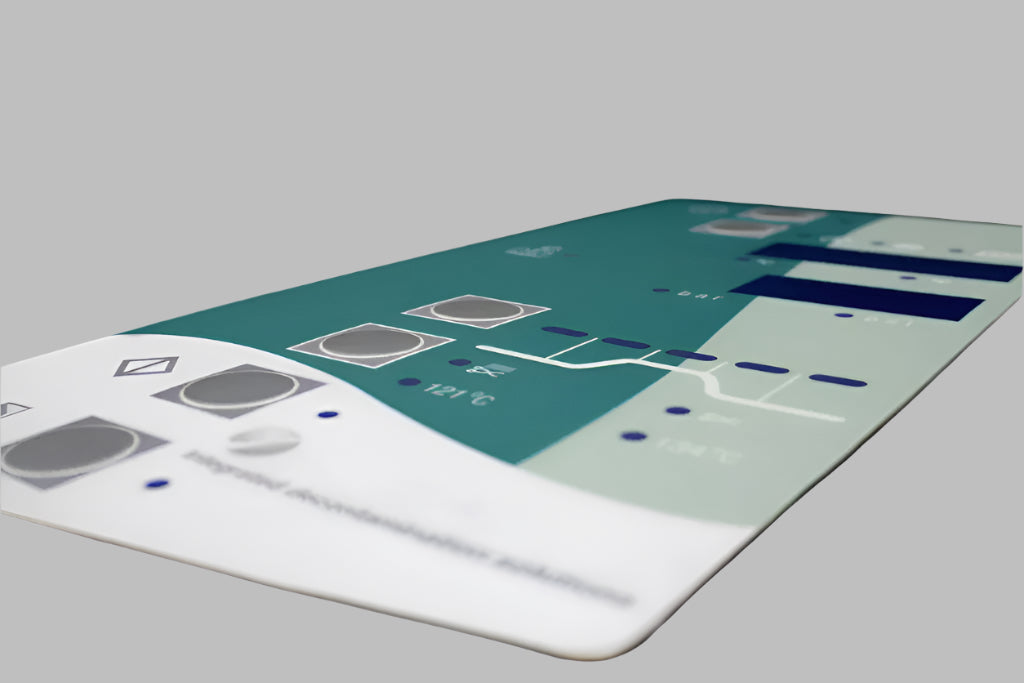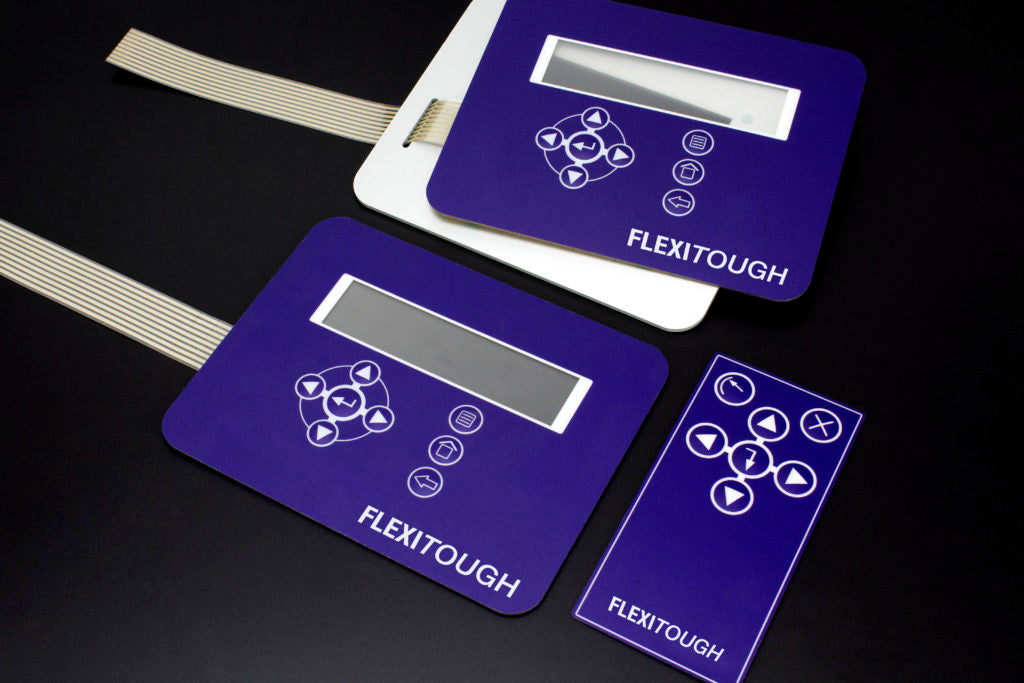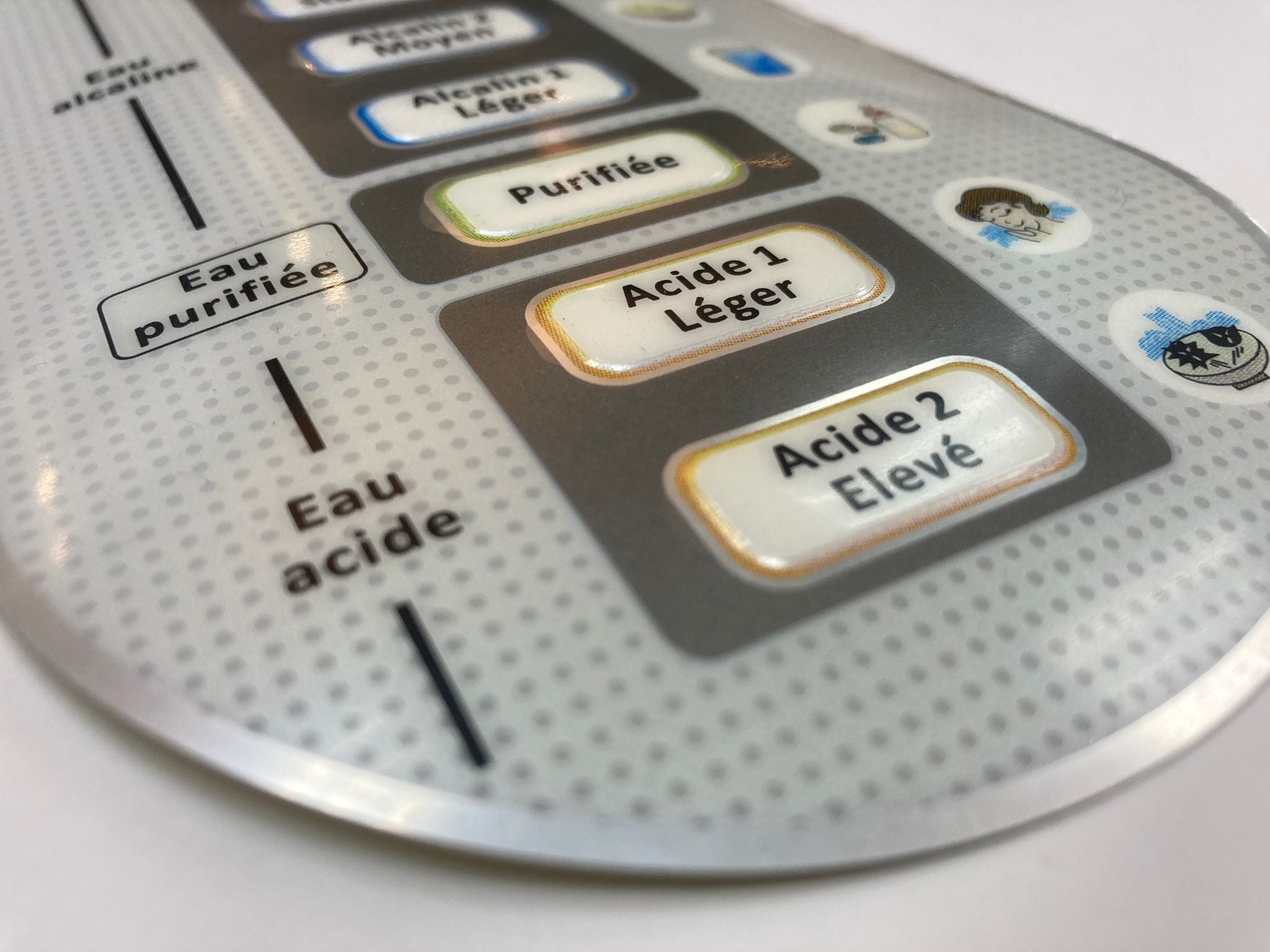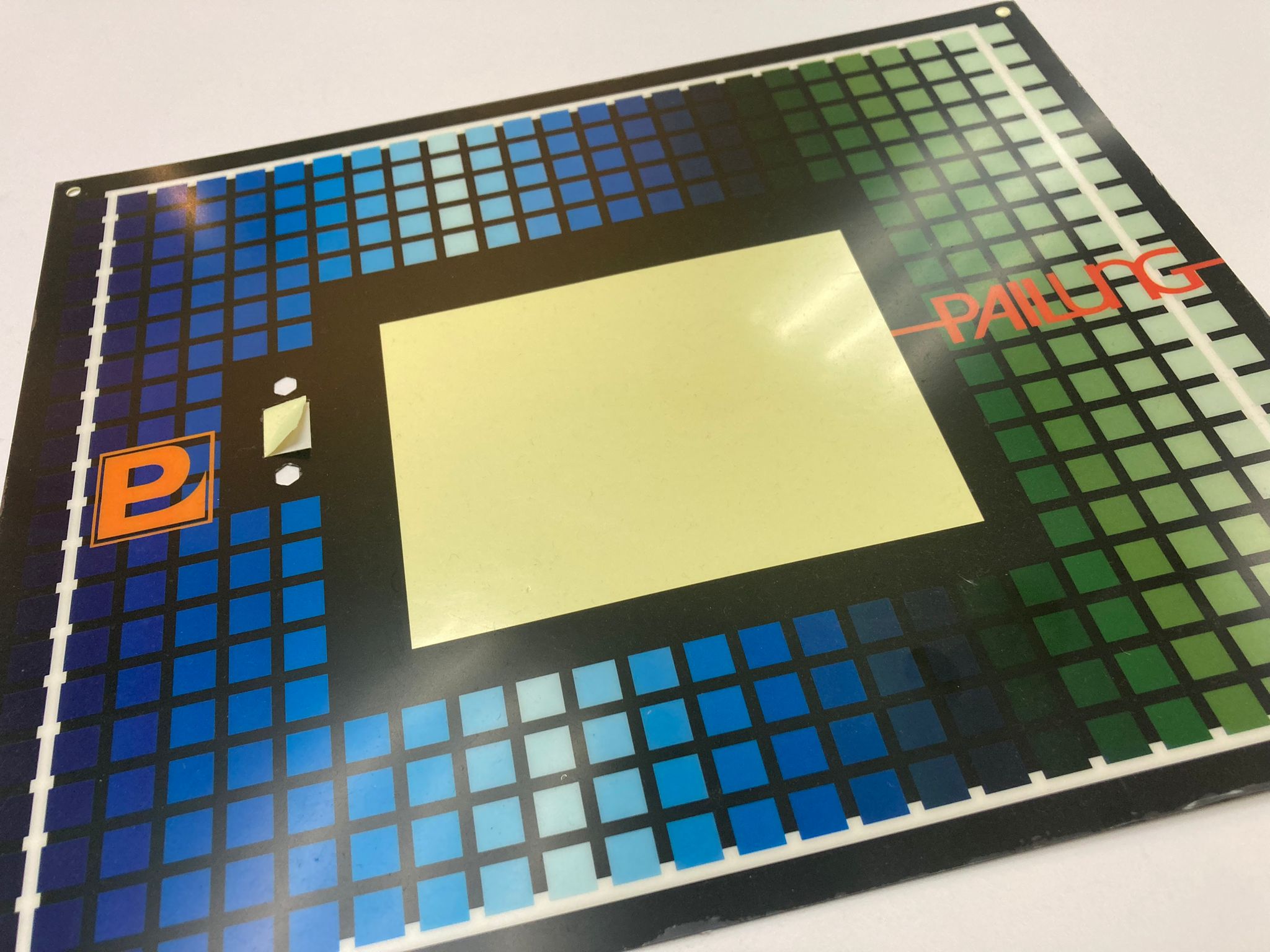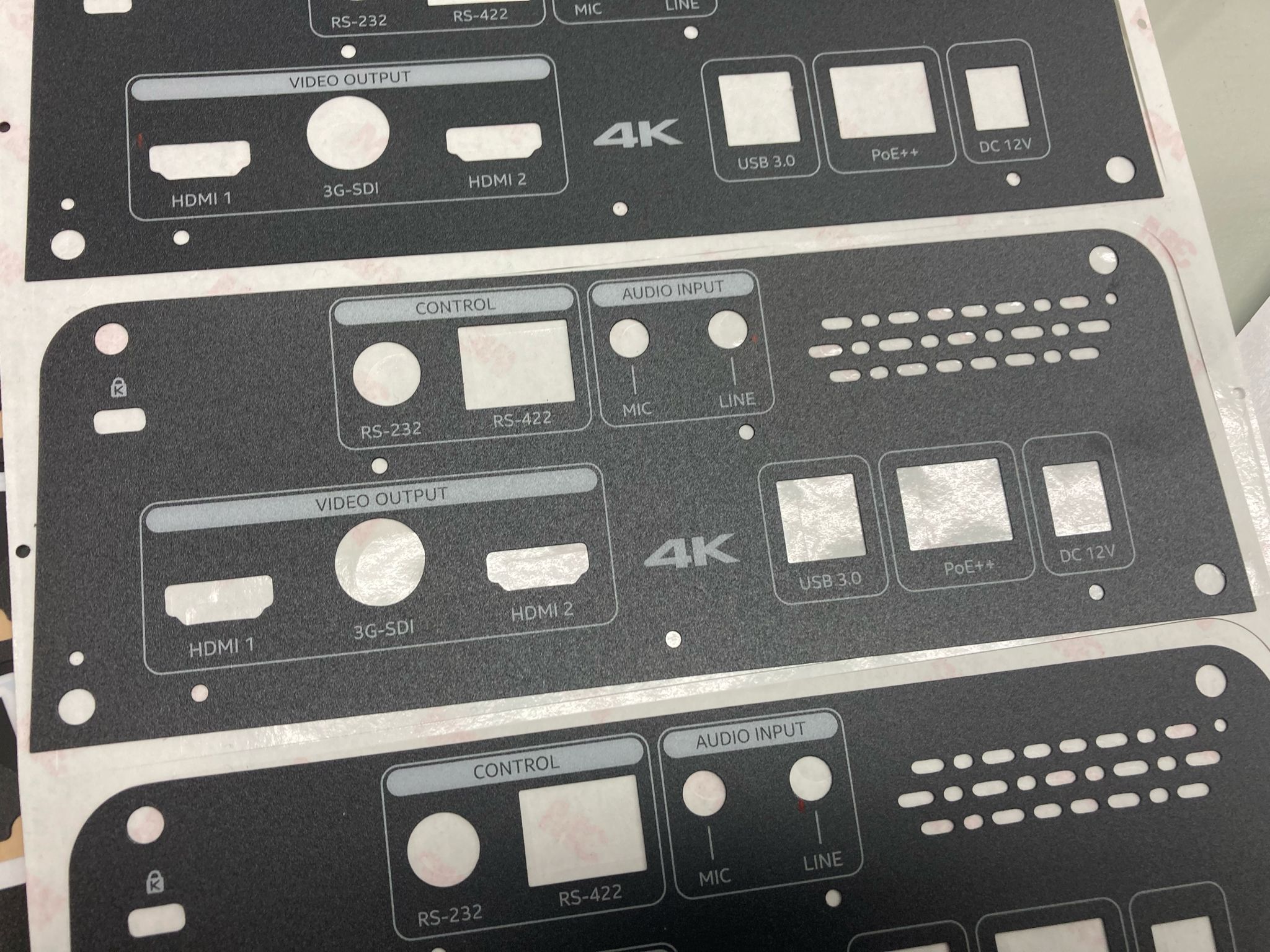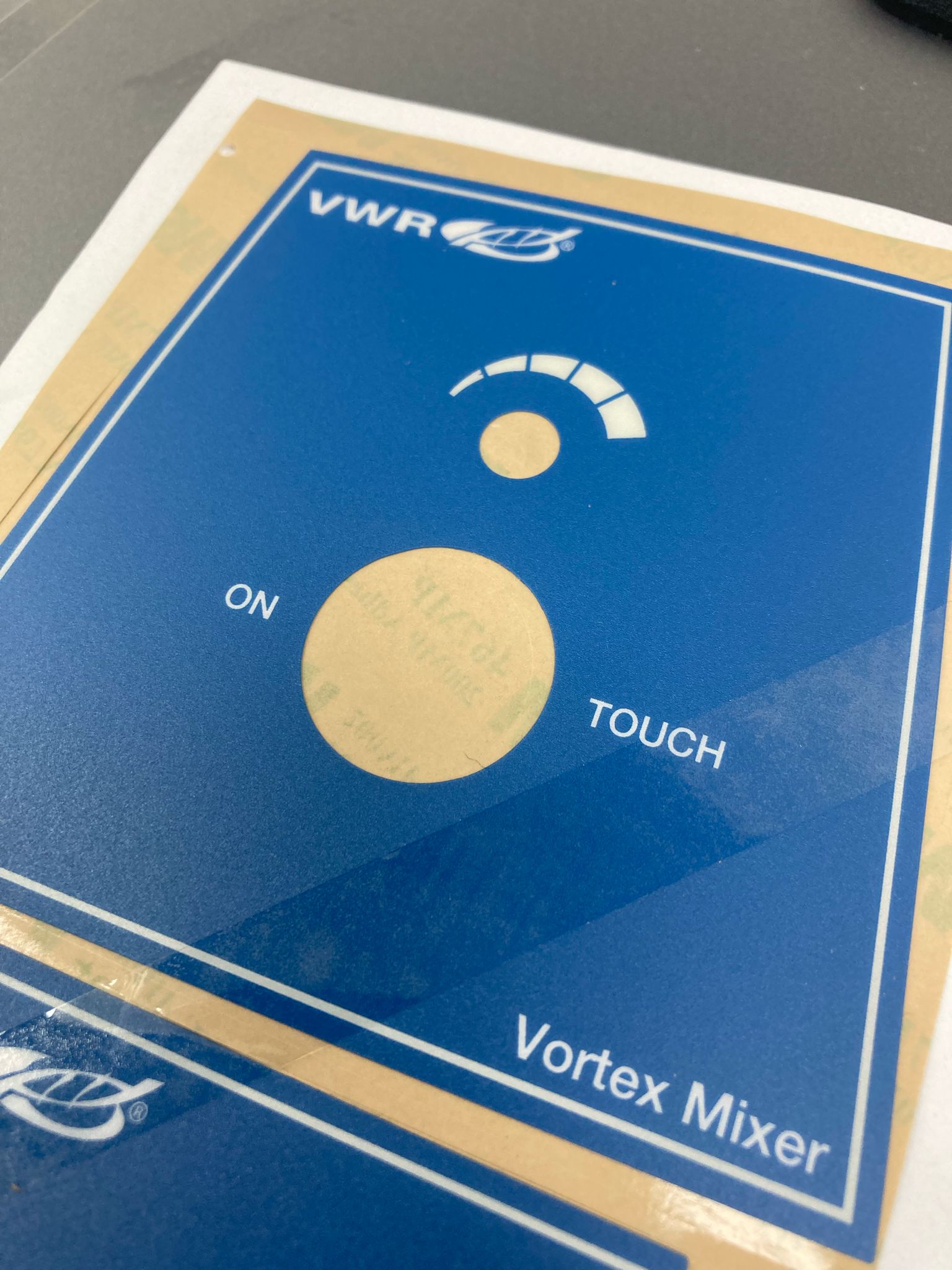
Graphic Overlays, Precision Made
Graphic overlays, also known as graphic panels, facelates and user interface panels, act as a crucial interface, ensuring your products not only withstand environments with extreme temperatures, exposure to elements like dirt, sand, dust, and water, but also harsh chemicals and UV rays. By using materials such as polycarbonate or polyester, these overlays can incorporate features like embossed buttons, clear display windows, and protective shielding, all while vividly representing your brand through color and design. This attention to detail in design and material choice means you get an overlay tailored to offer resilience and enhance user interaction with your product, making your brand more memorable and engaging for your customers. This strategic investment in customized graphic overlays directly contributes to the durability and appeal of your product in the market.
-
Polyester
Learn MorePolyester graphic overlays are a top choice for applications demanding exceptional durability and resistance to harsh environments. These overlays are known for their remarkable chemical resistance, abrasion durability, and ability to withstand extreme temperatures, making them ideal for industrial, medical, and consumer goods sectors. Polyester can endure about 1 million switch actuations before showing signs of wear, ensuring long-term reliability for membrane switch graphic overlays, control panel graphic overlays, and custom graphic overlay printing. Compared to polycarbonate overlays, which excel in impact strength, heat resistance, and ease of printing, polyester offers superior durability against chemicals and abrasions. This makes polyester overlays suitable for environments exposed to harmful substances and prolonged UV exposure, addressing common pain points such as chemical degradation and physical wear. However, processing polyester can be more challenging due to its higher material memory and tendency to shrink during low-temperature ink curing, potentially affecting lead times and costs. Despite these challenges, polyester's robustness makes it the preferred choice for demanding applications, whereas polycarbonate may be favored for its aesthetic versatility in digital graphic overlays, animated twitch graphics, and motion graphics overlays.
-
Polycarbonate
Learn MorePolycarbonate graphic overlays offer high impact strength, heat resistance, and ease of printing, making them suitable for applications requiring robust visual appeal and versatile design options. However, when it comes to chemical resistance and durability in harsh environments, polyester graphic overlays are superior. Polyester can endure about 1 million switch actuations before wear, making it ideal for demanding applications such as control panel graphic overlays, membrane switch graphic overlays, and custom graphic overlay printing in industrial, medical, and consumer goods sectors. Its resilience against extreme temperatures and chemicals addresses common pain points like exposure to harmful substances and prolonged UV exposure. While polycarbonate is favored for its ease of customization in digital graphic overlays and motion graphics overlays, it may not withstand harsh conditions as effectively as polyester. Polyester's higher material memory and tendency to shrink during low-temperature ink curing can pose processing challenges, potentially affecting lead times and costs. For frequent use and harsh environments, polyester provides unmatched durability, whereas polycarbonate might be preferred for applications prioritizing aesthetic flexibility and ease of production.
-
Combination
Learn MoreCombining polyester and polycarbonate to create custom graphic overlays can provide you with the best of both materials, offering a versatile and durable solution for various applications. Polyester, known for its superior chemical resistance, durability, and excellent flexibility, is ideal for overlays that need to withstand harsh environments and frequent use. On the other hand, polycarbonate offers high impact resistance, clarity, and ease of printing, making it perfect for applications requiring a more detailed and visually appealing finish. Using both materials together can be particularly advantageous in creating multi-functional overlays. For instance, you might choose polyester for the top layer to benefit from its durability and chemical resistance, while using polycarbonate as a base layer to leverage its structural strength and clarity. This combination can address pain points such as limited durability of single-material overlays and the need for frequent replacements due to wear and tear. A practical example of this combination is in control panels for industrial or medical equipment where the overlay needs to be both tough and visually clear for precise readings and instructions. The polyester layer can protect the graphics from solvents and abrasion, while the polycarbonate layer ensures the overall structure remains intact under impact. However, there are limitations to consider. Combining these materials can increase production complexity and cost, and the bonding process must be carefully managed to avoid issues such as delamination. Despite these challenges, the combined use of polyester and polycarbonate in graphic overlays offers a highly effective solution that enhances durability, aesthetic appeal, and functionality. To ensure premier quality and performance of your custom graphic overlays, collaborate with Trailblazer who specializes in these materials can help you navigate the technical requirements and achieve the best results for your specific applications.
-
Screen Printing
Learn MoreScreen printing for graphic overlays offers a robust and versatile solution for premier, durable designs. This traditional printing method uses a mesh screen to transfer ink onto the overlay material, providing a rich, vibrant finish that is particularly effective for bold and opaque colors. Ideal for applications where longevity and resistance to environmental factors are crucial, screen printing is commonly used for industrial equipment, automotive panels, and durable consumer products. One of the primary benefits of screen printing is its ability to produce thick ink deposits, resulting in highly durable prints that can withstand heavy wear, UV exposure, and harsh chemicals. This makes it a preferred choice for overlays that need to endure challenging conditions while maintaining their visual integrity. Additionally, screen printing can be applied to a variety of materials, including polycarbonate, polyester, and vinyl, offering flexibility in your choice of substrate. Technically, screen printing excels in creating uniform color areas and sharp edges, making it perfect for designs that require high contrast and solid colors. This method can also incorporate special inks, such as metallic or UV-reactive inks, to add unique effects to your overlays. However, one limitation is that screen printing is less efficient for highly detailed images or small text, where digital printing might be more suitable. In comparison to digital printing, which offers rapid setup and customization for short runs, screen printing is more cost-effective for large volumes due to its lower per-unit cost at scale. Offset printing, on the other hand, is better suited for achieving fine details and color gradients but does not match the durability of screen-printed overlays. By choosing screen printing for your graphic overlays, you invest in a process that ensures your designs are not only visually striking but also built to last. This method addresses pain points such as fading and wear, providing a long-lasting solution for demanding applications. To explore how screen printing can meet your specific needs, consider working with experienced manufacturers who specialize in this technique to achieve the best results for your project.
-
Digital Printing
Learn MoreDigital printing for your graphic overlays offers a blend of versatility and precision that is hard to match. This advanced printing method directly transfers digital images onto materials like polyester and polycarbonate, allowing for intricate designs and vibrant colors. One of the key advantages of digital printing is its flexibility; it excels in producing small to medium-sized batches efficiently, making it perfect for prototypes, custom orders, and frequent design changes without the added costs associated with traditional printing setups. Digital printing stands out for its ability to handle detailed and complex graphics with ease. Whether you need high-resolution images, fine text, or gradients, digital printing can deliver superior quality. This is particularly beneficial for creating overlays with personalized information, such as serial numbers or variable data, which can be seamlessly integrated into the printing process. In comparison, offset printing might be more economical for large-scale production, and screen printing is ideal for bold, opaque colors and durability. However, digital printing’s strength lies in its speed and adaptability. It eliminates the need for plates or screens, reducing preparation time and enabling quick turnarounds, which is crucial in today’s fast-paced market environments. A potential limitation of digital printing is its cost-effectiveness at very high volumes, where traditional methods might offer better economies of scale. Also, while the durability of digital prints has significantly improved, they may not always match the robustness of screen-printed graphics under extreme conditions. By opting for digital printing, you ensure that your graphic overlays are not only visually striking but also produced with a high degree of flexibility and efficiency. This method allows you to stay agile, adapting to market trends and customer demands with ease. To determine the best approach for your specific needs, consider the nature of your project, the required batch size, and the complexity of the designs. Digital printing provides a modern solution that combines quality, speed, and customization, making it a valuable choice for dynamic and responsive production.
-
Offset Printing
Learn MoreOffset printing for graphics overlays offers several advantages that can enhance your product's appearance and durability. Offset printing, a traditional method, uses a plate to transfer ink onto a rubber blanket, then onto the printing surface, providing high-end and consistent results. Compared to digital and screen printing, offset printing excels in producing sharp and detailed images, making it ideal for intricate designs and high-volume orders. With offset printing, you can achieve precise color matching and vibrant, long-lasting prints. This method is particularly valuable when you require consistent quality across large batches, as it maintains the same level of detail and color fidelity from the first print to the last. Offset printing is also cost-effective for high-volume production, reducing the cost per unit as the quantity increases. However, offset printing has some limitations. The initial setup cost is higher due to the need for printing plates and longer preparation times. This makes it less suitable for short runs or projects requiring frequent design changes, where digital printing offers more flexibility and lower setup costs. Screen printing, on the other hand, is excellent for producing bold, opaque colors and is ideal for printing on various materials and surfaces, but it may not achieve the same level of detail and precision as offset printing. For your graphic overlays, choosing offset printing means investing in a method that ensures premier quality and durability, particularly for large production runs. This technique is ideal if you prioritize detailed imagery and consistent results. To determine if offset printing is the best choice for your specific needs, consider factors such as the volume of your order, the complexity of your design, and your budget. By leveraging the strengths of offset printing, you can create visually stunning and durable overlays that stand out in the market.
-
Embossing
Learn MoreGraphic overlay embossing is a specialized technique that adds a three-dimensional aspect to your custom overlays, significantly enhancing the user interface's tactile and visual appeal. This process involves raising specific areas of the overlay, such as lettering, designs, or buttons, by using precision tools and applying heat and pressure. Embossing can be applied to various materials, including polycarbonate, polyester, and metals like aluminum and steel, making it versatile for different applications. The value of embossing graphic overlays lies in its ability to improve both functionality and aesthetics. For instance, embossed buttons on overlays provide tactile feedback, making it easier for users to navigate and operate devices, even in low-light conditions. This tactile feedback reduces user errors and enhances overall user satisfaction and efficiency. Additionally, embossing can highlight branding elements, giving your product a premium look that stands out in the market. Embossing addresses several pain points. It enhances the durability of the graphics by protecting them from wear and tear, as the embossed areas are less likely to fade or be damaged by frequent use. It also helps in creating distinct areas on the overlay, which can improve the usability of devices by clearly differentiating buttons and controls. However, there are some limitations to consider. The depth and precision of the embossing depend on the material used; for example, polycarbonate and polyester have different spring-back characteristics, affecting the final embossed height. Embossing also requires precise tooling, which can add to the initial setup costs, making it less cost-effective for very small production runs compared to other printing methods. This technique is highly beneficial for various industries, including medical devices, automotive controls, and consumer electronics, where durability and clarity are paramount.
-
Dead Fronts
Learn MoreDead fronting in graphic overlays offers a unique solution for creating clean and intuitive user interfaces by concealing icons and symbols until they are backlit. This technique is commonly used in automotive dashboards, aerospace indicators, medical devices, and various control panels where clear and effective communication of information is crucial. Dead front overlays are produced using precise printing techniques, often involving multiple layers of ink to achieve the desired opacity and reveal graphics only when illuminated. This process ensures that unused icons remain hidden, providing a sleek and uncluttered appearance until needed. For instance, a dashboard indicator for a check engine light remains invisible until the light source activates it, enhancing both functionality and aesthetic appeal. The value of dead fronting lies in its ability to simplify complex interfaces, making them more user-friendly and visually appealing. By hiding non-essential information, it reduces visual clutter, allowing users to focus on critical alerts and indicators when necessary. This improves user experience, particularly in low-light conditions or environments where quick, clear information is essential. However, there are some limitations to consider. Achieving uniform backlighting can be challenging, especially in ensuring that all parts of the icon are evenly lit without shadows or hotspots. This often requires the use of light diffusers and precise alignment during the manufacturing process. Additionally, developing the perfect dead front overlay may involve multiple prototypes to get the balance of opacity and illumination just right, which can add to development time and cost. Despite these challenges, the benefits of dead front graphic overlays in enhancing user interfaces and product aesthetics make them a valuable choice for many industries.
-
Windows
Learn MoreWindows on graphic overlays offer significant advantages by enhancing both functionality and user experience. These transparent sections within the overlay allow users to view underlying displays or indicators, such as LCDs, LEDs, or other visual elements, making them essential for various applications. Commonly used in polycarbonate overlays and custom graphic overlay designs, windows ensure that important information is visible without compromising the overlay’s protective qualities. This feature is particularly valuable for control panel graphic overlays and membrane switch graphic overlays, where clear visibility of dynamic data is crucial. Integrating windows into your graphic overlays addresses several pain points. For instance, it eliminates the need to create separate viewing areas, thereby maintaining the integrity and durability of the overlay. This is especially beneficial in environments where overlays are exposed to harsh conditions, as the window ensures that the display remains protected from dust, moisture, and other contaminants. Additionally, windows can enhance the aesthetic appeal of the overlay, contributing to a sleek and modern design. However, there are some limitations to consider. The integration of windows can complicate the manufacturing process, potentially increasing production time and costs. It is also essential to ensure that the window material is optically clear and durable, which might limit material choices. For instance, while polycarbonate is a popular choice for its clarity and durability, other materials might offer different advantages but may not match the same level of performance. Windows are ideal in scenarios where visibility of underlying components is necessary, such as in medical devices, industrial equipment, and consumer electronics. For example, digital graphic overlays and membrane graphic overlays often incorporate windows to display real-time data or status indicators, enhancing usability and functionality. When combined with advanced printing techniques like digital printed overlays and motion graphics overlays, windows can significantly elevate the interface design, making them a valuable feature for custom overlays, control panel overlays, and more.
-
Backlighting
Learn MoreIntegrating backlighting into your graphic overlays can significantly enhance the functionality and visual appeal of your product interfaces. Backlighting involves illuminating specific areas of the overlay, such as icons, buttons, or entire panels, to improve visibility in low-light conditions and create a more dynamic and user-friendly experience. There are various methods of backlighting, including LEDs, electroluminescent (EL) panels, and fiber optics. LED backlighting is highly versatile, offering bright, consistent illumination with the option for multiple colors. EL panels provide uniform light and are ideal for applications requiring thin, flexible lighting solutions. Fiber optic backlighting is excellent for achieving even illumination over larger areas while maintaining a slim profile. The value of backlighting lies in its ability to enhance usability and aesthetics. For instance, backlit overlays on control panels can ensure critical information and controls are visible at all times, improving safety and efficiency in industrial or medical settings. This feature is also beneficial for automotive dashboards, making essential indicators easily readable in various lighting conditions. Backlighting addresses pain points such as poor visibility in dim environments and enhances the overall user interface by making controls more intuitive and accessible. However, incorporating backlighting can increase the complexity and cost of the overlay design. It requires careful consideration of factors like light transmission, color uniformity, and power requirements to achieve the desired effect without compromising durability. Backlighting is particularly ideal for applications in medical devices, industrial machinery, automotive dashboards, and consumer electronics where clear visibility of controls and indicators is crucial. By choosing the appropriate backlighting technology, you can significantly improve the user experience and functionality of your graphic overlays.
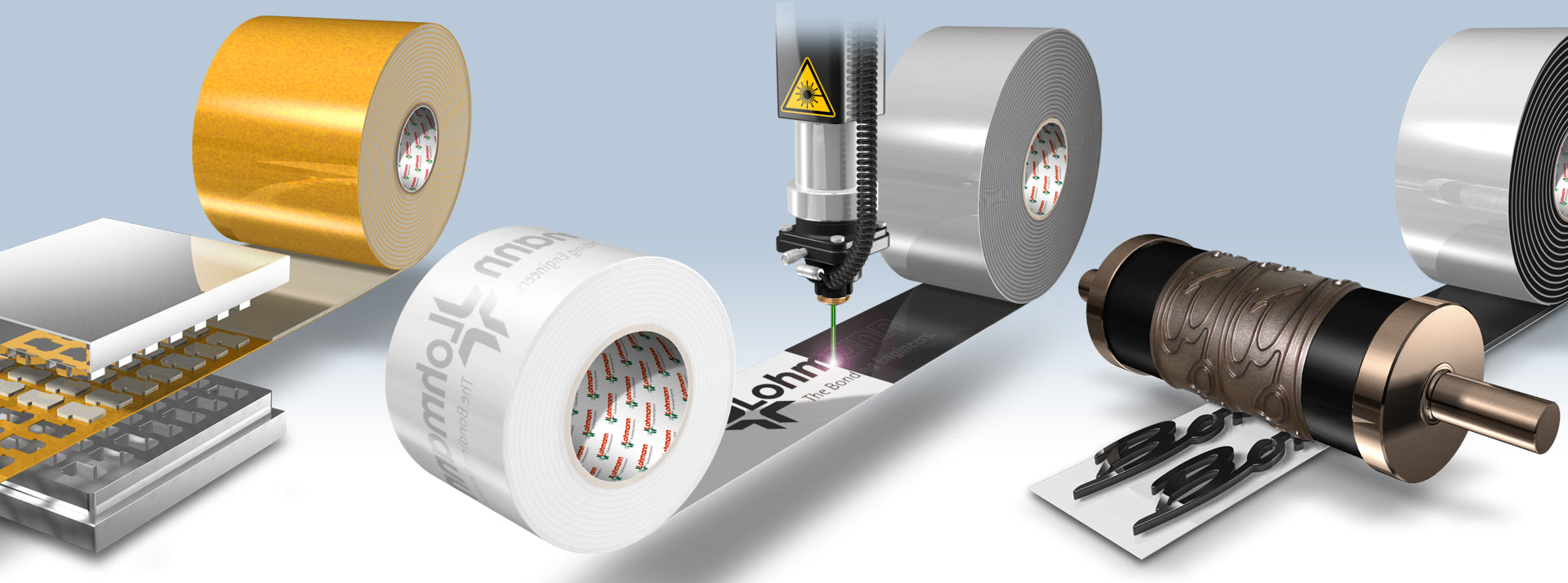
Graphic Overlay Adhesives
When it comes to securing graphic overlays, choosing the right adhesive is crucial for ensuring long-lasting durability and performance. 3M adhesives are widely regarded as the industry standard, offering a range of options tailored to different materials and environmental conditions. Commonly used adhesives include 3M™ Adhesive Transfer Tape 467MP and 468MP, both featuring the 200MP acrylic adhesive known for its high performance. These tapes provide excellent adhesion to metals and high surface energy plastics, ensuring a strong bond that resists slippage and edge lifting. Another popular choice is the 3M™ Double Coated Tape 9472LE, which offers robust adhesion even on low surface energy plastics and performs well under high temperatures and humidity. Using these high-quality 3M adhesives in your graphic overlay applications guarantees a reliable and enduring attachment, addressing common issues like peeling and detachment, while enhancing the overall durability and functionality of your product.
Substrate
For custom control panels, polyester and polycarbonate are the primary choices, with polyester known for its toughness and polycarbonate for its flexibility in manufacturing processes like embossing. Trailblazer enhances these by combining both materials to harness their optimal qualities.
Placement
Understanding the specific dimensions and placement of your graphic overlay on your product is crucial, especially if it needs to fit precisely within a recess and maintain flush alignment with the surface. Trailblazer tailors these overlays and displays to match any required size or contour, ensuring a perfect fit for every application.
Color Match
Ensuring your product's overlay aligns with your brand's color scheme is crucial. We can precisely match colors using various references like Pantone chips or your existing product components, backed by advanced color-matching technology and digital printing capabilities.
Embossing
Embossing adds a tactile dimension to graphic overlays, improving both aesthetics and user interaction. It's crucial in environments requiring enhanced touch feedback, influencing material selection. Our capabilities include sophisticated embossing techniques such as pillow, rim, and dome styles, as well as the ability to emboss logos and complex shapes, offering customized solutions to meet diverse design requirements.
Windows
Trailblazer excels in providing windows and lenses with unparalleled optical clarity, with precision-cut premium materials for any application. Expertly combine substrates, films, and colors to meet specialized needs, from military gear requiring anti-glare properties to medical devices, ensuring flawless performance across all environments.
Adhesive
Selecting the right adhesive for your project hinges on understanding your housing's material characteristics, including surface energy and texture, as well as any special coatings like powder paint. Trailblazer possesses the expertise to guide you in choosing the optimal adhesive solution, ensuring strong and lasting bonds tailored to your specific requirements.
-
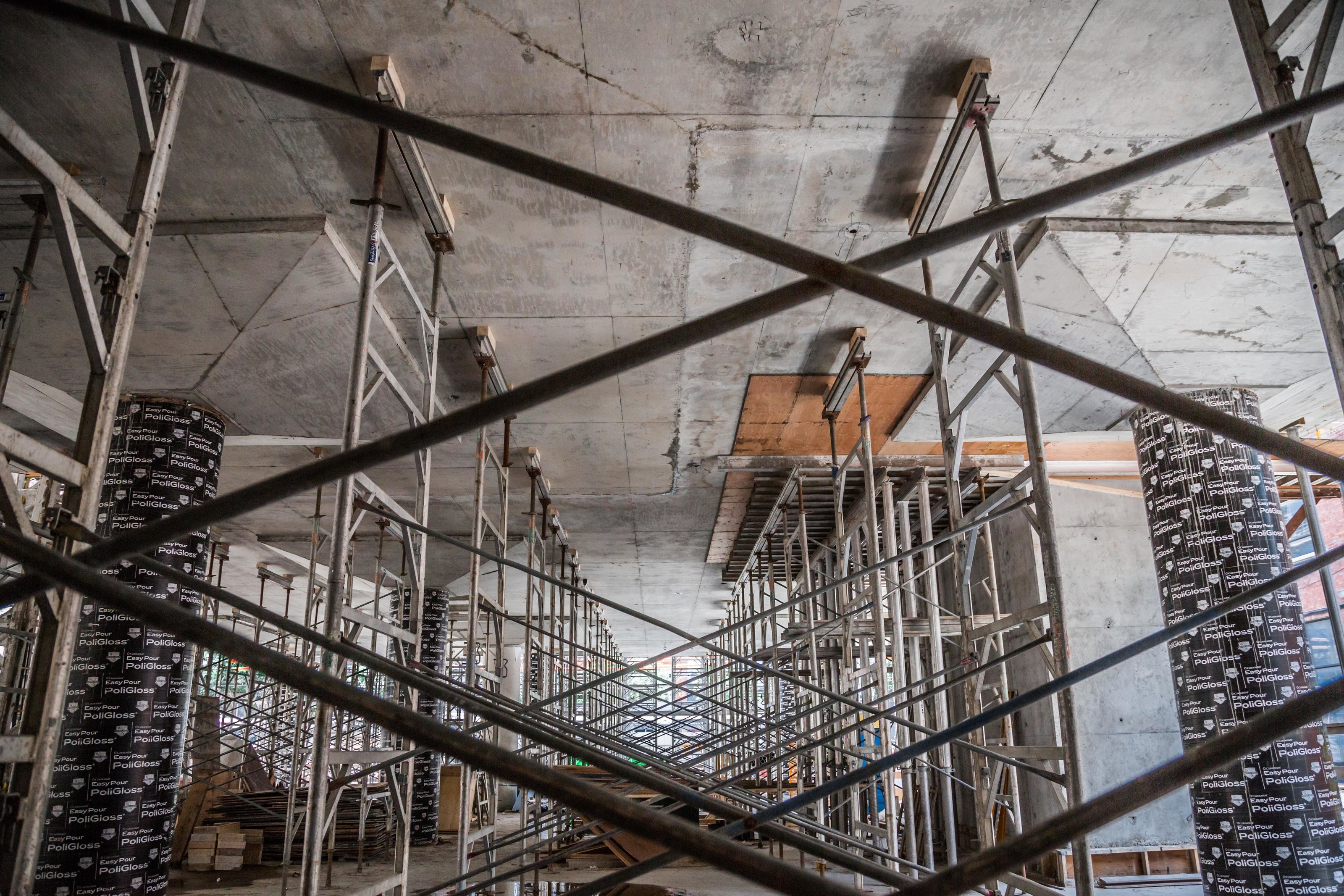
Construction
Learn MoreIn the construction industry, graphic overlays play a crucial role in enhancing the durability and functionality of equipment and machinery controls. These overlays are applied to devices and panels, providing clear labeling for operational buttons and controls, safeguarding against harsh environmental conditions like dust, moisture, and continuous use. They also aid in maintaining the aesthetic integrity of equipment interfaces, contributing to user-friendly operation and safety standards on construction sites. Graphic overlays ensure that critical equipment remains functional and accessible, even in demanding construction environments.
-

Fitness
Learn MoreIn the fitness industry, graphic overlays are essential for enhancing the usability and safety of electronic exercise equipment. Custom control panel overlays, designed by Trailblazer, offer clear instructions and make equipment like treadmills, elliptical machines, and stationary bicycles user-friendly for all levels of fitness enthusiasts. These overlays are made from durable materials such as polyester and polycarbonate, protecting against wear and environmental factors while also allowing for the inclusion of brand logos and detailed usage instructions, thus improving the overall user experience.
-

Manufacturing & Industrial
Learn MoreGraphic overlays are integral to the manufacturing and industrial sectors, where they are utilized on control panels, heavy machinery, and equipment requiring clear operational instructions and safety warnings. These overlays enhance durability, user interface clarity, and equipment aesthetics across various applications, including assembly lines, industrial control systems, and machinery operation panels, ensuring efficient and safe workplace operations.
-

Dental & Medical
Learn MoreIn the dental and medical fields, graphic overlays are crucial for labeling and operating various types of equipment. They are extensively used on dental apparatus, medical imaging machines, warming cabinets for medical blankets, blood pressure monitors, and devices requiring clear, durable labels for asset management, control panels, and safety warnings. These overlays ensure devices are user-friendly, safe, and compliant with health standards, significantly impacting patient care and healthcare professionals' efficiency.
-

Marine
Learn MoreIn the marine industry, graphic overlays are essential for boat switch panels, serving as the control center for a vessel's electrical systems. These overlays are tailored to accommodate various switches, gauges, and dials, ensuring clear labeling and operation of the boat's electrical capabilities. Durability and resistance to fading from UV exposure and extreme marine conditions are critical, as these overlays must remain legible and functional to support safe and efficient navigation.
-

Aerospace
Learn MoreIn the aerospace industry, graphic overlays are utilized for a wide variety of applications, including instructional and warning labels, aviation tags, schematics, and specially designed dials and instrumentation. These overlays are essential for ensuring clarity, durability, and usability of aerospace equipment, catering to the rigorous demands of the sector.
-

Research Labs
Learn MoreIn research labs, custom graphic overlays are used on various equipment such as instruments and devices that require precise control markings, dials, safety instructions, and branding. These overlays, made from materials like polycarbonate and polyester, can be customized to include dead front graphics that only appear when backlit, enhancing functionality and usability in lab settings. They are essential for ensuring equipment is user-friendly and operates safely.
-

Transportation
Learn MoreIn the transportation industry, graphic overlays are extensively used for custom signage, bus wraps, and graphics to create a unified and recognizable appearance for transit systems. These elements not only enhance the visual appeal of transportation but also play a crucial role in establishing an identity and increasing community engagement and ridership. Companies specialize in durable materials and innovative printing technologies to ensure these graphics withstand everyday wear and tear.
-

Food Industry
Learn MoreIn the food service industry, graphic overlays are crucial for equipment like blenders, ensuring user-friendly interfaces and proper equipment identification. These overlays can withstand harsh kitchen environments, including exposure to heat, grease, and cleaning chemicals, maintaining durability and clarity for operational instructions and safety warnings. Customization options like embossed buttons and clear windows for displays enhance functionality and user interaction.
-

Agriculture
Learn MoreIn agriculture, custom membrane switches and overlays are essential for a wide range of farming equipment, including irrigation systems, specialized machinery, heavy equipment, and sprayers. These components are designed to be durable and reliable, able to withstand extreme weather conditions and improve the usability of agricultural products with features like integrated LED lighting for day and night use. For more detailed information, contact a Trailblazer expert for guidance on agricultural membrane switches and overlays.
-

Retail
Learn MoreGraphic overlays in retail enhance equipment interfaces by providing durable, functional, and visually appealing control panels. These overlays, often crafted from polycarbonate, safeguard against environmental damages while ensuring clear communication and brand representation on devices. They are vital for a positive user interaction with retail machinery and equipment.
-

Consumer Products
Learn MoreIn the consumer appliance industry, durability and visual differentiation are key factors for membrane switches and graphic overlays. These components need to withstand various environments, moisture, and chemicals. Trailblazer specializes in creating durable, visually appealing designs that meet these demands, including unique material finishes and backlighting innovations for standout consumer appliances. Expertise ensures products are both reliable and aesthetically pleasing, catering to the ever-evolving trends and demands of the consumer market.
Graphic Overlay FAQs
What are graphic overlays?
Graphic overlays are a versatile and critical component in enhancing the functionality and aesthetics of various devices across multiple industries, including medical, automation, aviation, consumer electronics, and more. They provide a user-friendly interface that simplifies the interaction between the user and the device, while also offering protection and durability under diverse operational conditions. Let's delve into the essentials of graphic overlays and how they can add value to your product.
What Are Graphic Overlays?
At their core, graphic overlays are thin layers of material—typically plastic—printed with text, symbols, or graphics, acting as the interface between the user and the device. They're not just about aesthetics; they play a crucial role in protecting the device from environmental hazards, ensuring durability, and improving user experience by making the device easier to navigate.
Design Considerations
When designing a graphic overlay, several key factors must be considered to ensure that the overlay meets the specific needs of your product and its users:
1. Size and Design Specifications: The overlay should fit perfectly on the device, with a design that's both functional and aesthetically pleasing. This includes considering the layout, color scheme, and placement of interactive components like buttons and indicators.
2. Performance Capabilities: Durability, readability under different lighting conditions, and optical clarity (especially if the overlay covers displays or indicators) are critical to ensure that the overlay performs reliably under various environmental conditions.
3. Material Choice: The selection of material is crucial, with polycarbonate and polyester being popular choices due to their durability and resistance to environmental factors. The material affects the overlay's tactile feel, durability, and overall performance.
4. Customization Options: Custom fabrication technologies allow for intricate designs, color management to fit branding needs, and specific finishes like velvet or gloss to protect and enhance the overlay's appearance.
Applications and Benefits
Graphic overlays are found in a wide array of applications, from medical devices and industrial equipment to consumer electronics and automotive controls. They provide clear instructions, enhance safety by reducing operational confusion, and add a layer of protection against environmental damage.
Adding Value to Your Product
Incorporating a well-designed graphic overlay can significantly enhance your product's value by:
1. Improving Usability: By making interfaces more intuitive and easier to navigate, you enhance the end-user experience, potentially reducing the learning curve and increasing satisfaction.
2. Enhancing Durability: High-quality materials and proper design protect against wear and tear, extending the product's lifespan and reducing maintenance costs.
3. Boosting Aesthetics: A well-crafted overlay can improve the overall look of your product, making it more appealing to customers and helping it stand out in the market.
Graphic overlays are more than just decorative elements; they are functional components that enhance user experience, protect your device, and contribute to your product's success in the market. Considering the design, material, and application of graphic overlays carefully can provide significant benefits, adding value for both you and your customers. Whether you're in the early stages of product design or looking to improve an existing product, understanding the importance and potential of graphic overlays is crucial.
Can acrylic be used as a substrate for graphic overlays?
Acrylic, known for its clarity, durability, and versatility, serves as an excellent material for graphic overlays in various applications. Whether you're looking to enhance the aesthetic appeal of a device or ensure its functionality and durability, acrylic offers a wealth of benefits that can be tailored to meet your specific needs.
Durability and Resistance
Acrylic overlays are renowned for their resistance to the elements. This material can withstand exposure to sunlight, rain, and temperature extremes without losing its color or clarity, making it an ideal choice for outdoor applications or environments subject to harsh conditions. Its robustness ensures that the overlay remains functional and visually appealing over time, protecting underlying graphics from wear and tear.
Clarity and Aesthetics
One of the most compelling attributes of acrylic is its optical clarity. This allows for vibrant, clear graphics that are easy to read and visually striking. Acrylic overlays can be customized with a wide range of colors and textures, enabling designers to achieve the exact look they desire for their product. Whether you aim for a glossy finish that catches the eye or a matte surface that reduces glare, acrylic can be adapted to fulfill these aesthetic requirements.
Versatility in Printing and Customization
Acrylic is amenable to various printing techniques, including screen printing, digital printing, and even laser etching, allowing for intricate designs and precise detailing. This versatility makes it possible to include complex logos, detailed instructions, or any other graphical elements directly onto the overlay with high fidelity and color accuracy. Furthermore, acrylic can be easily cut and shaped, offering endless possibilities in terms of design flexibility and customization to fit specific device configurations.
Applications
Acrylic overlays find applications across a broad spectrum of industries, from consumer electronics, where they add a sleek, modern touch to devices, to industrial machinery, providing a durable interface that withstands rigorous use. They are also prevalent in medical devices, automotive dashboards, and household appliances, where their clarity ensures critical information is easily accessible, and their durability guarantees longevity even in demanding environments.
Considerations
When opting for acrylic as a material for graphic overlays, it's important to consider the specific requirements of your application. Factors such as the expected exposure to chemicals, UV light, and physical impacts will dictate the thickness and treatment of the acrylic overlay. Additionally, while acrylic is more durable and resistant than many other materials, it is not indestructible and should be chosen with an understanding of its limitations.
Acrylic overlays offer a compelling combination of visual appeal, durability, and customization options, making them a popular choice for enhancing the user interface of devices across many fields. By carefully considering your project's specific needs and leveraging the inherent benefits of acrylic, you can create graphic overlays that not only look fantastic but also stand the test of time. Whether you are designing a new consumer product or looking to improve an industrial device, acrylic provides a flexible and robust solution that can elevate the end user's experience.
What finishes do you offer for overlays?
1. Lamination involves covering materials with films like polyester, polycarbonate, or vinyl to enhance their durability, appearance, or to add special effects. This process can also involve applying pressure-sensitive adhesives to these films or sheets, simplifying the mounting process for the end product. By layering various materials, we can create products with unique properties, such as insulators, electromagnetic interference shields, or other customized solutions using metals like copper or aluminum foils for specific needs.
2. Slitting is a technique used to make a slit in the protective liner of adhesive products, facilitating an easy peel feature. It's an economical substitute for pull tabs on adhesive-backed items. Methods like power shearing and back slitting offer alternatives to more traditional cutting and die-cutting techniques, allowing for precise placement and easy handling or positioning of parts.
3. Die-cutting employs Steel Rule Dies for producing parts with specific shapes, internal cutouts, or for high-volume production. While many roll labels require custom tooling, existing shapes can often be created using standard tools. For sheet-fed items, Clamshell die cutters are used, and for smaller quantities or larger items, digital cutting techniques provide an efficient alternative without the need for traditional die purchases.
4. Power cutting or shearing uses a guillotine shear equipped with a digital controller for cutting films, thin sheets, and layered materials into precise shapes. This method is suitable for a wide range of materials and is particularly useful for creating square or rectangular shapes for various applications, including banners and sign inserts.
These processes collectively support the creation of materials with specific properties and functionalities tailored to various industrial applications, from electronic components to protective coatings for outdoor use. By combining different materials and employing precise cutting and lamination techniques, manufacturers can meet the diverse needs of their projects with high-quality, durable products.

